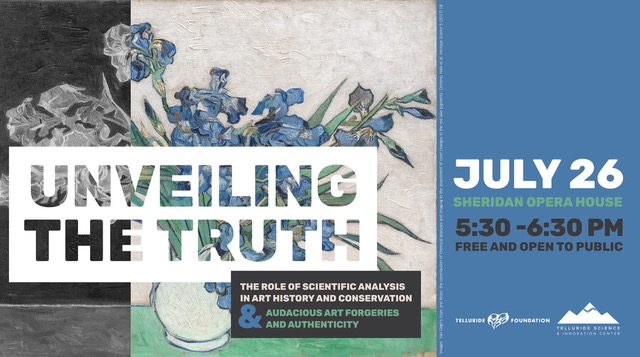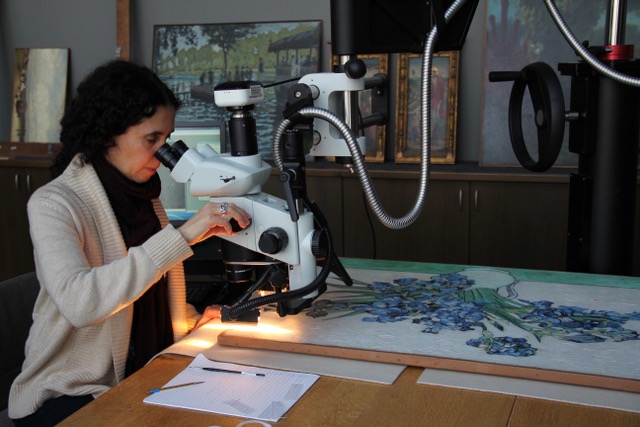
01 Jan Telluride Science & Telluride Foundation: “Unveiling the Truth,” 7/26!
Telluride Science and the Telluride Foundation host Dr. Silvia Centeno of New York’s Metropolitan Museum of Art and New York-based art historian and dealer Rachel Kaminsky. The very special talk about the inner workings of the art world takes place Wednesday, July 26, 5:30 – 6:30 pm, at the historic Sheridan Opera House. This program, titled “Unveiling the Truth: Scientific analysis in art history and conservation; and audacious art forgeries and authenticity,” is FREE and open to the public.
Visit telluridescience.org to learn more about Telluride Science and the capital campaign to transform the historic Telluride Depot into the Telluride Science & Innovation Center. The venue will be permanent home for Telluride Science and a global hub of inspired knowledge exchange and development where great minds get to solve great challenges.
Go here for more on Telluride Science.
Go here for more on the Telluride Foundation.
Go here for more on Town Talks.

Conservation is defined as the prevention of the wasteful use of a resource. Nowadays that generally means protecting, preserving, managing and/or restoring Planet Earth’s natural resources for current and future generations.
Remix “conservation” and apply the term to the world of fine art and the concept grows some interesting legs.
The value of a work of art is often tied to the signature of a specific mark-maker, plus the where and when of a piece. However, all bets are off the table when an image turns out to be a forgery. Establishing authenticity has clear repercussions, not only in terms of art history, but also economically and legally. ‘
Forgeries aside (just for a New York minute), we often assume whatever we see in the hushed surroundings of a museum always looked the same – and exactly the way the artist intended. However, like all of antiquities, fine art is at the mercy of time: a ticking clock brings prolonged exposure to light, moisture, dust, and other elements of nature that cause artwork to become dirty and/or damaged. While most museums today are designed to protect their collections from the elements, the unfortunate problem is that in all too many cases the damage has already been done: centuries of storage in less-than-ideal conditions will have greatly marred some of the world’s most important pieces.
What to do?
Short answer: Ask Dr. Silvia A. Centeno, a research scientist at the Metropolitan Museum of Art in New York.
Centeno and her colleague, New York-based art historian and dealer Rachel Kaminsky, will be in town to speak on the subject of “Unveiling the Truth: Scientific analysis in art history and conservation; and audacious art forgeries and authenticity.” The landmark event takes place Tuesday, July 26, 5:30 – 6:30 pm, at the historic Sheridan Opera House. It is the first of three collaborations co-hosted by Telluride Science and the Telluride Foundation and is free and open to the public.
Silvia Centeno will discuss the ever-growing importance of scientific analysis in the realm of art history, conservation, and preservation research. Using examples of paintings in the Met’s collection, she will demonstrate how non-invasive, cutting-edge tools are able to delve beneath the paint surface to reveal a wealth of valuable and sometimes surprising information unseen by the naked eye.
Art forgeries and the stories surrounding them, just as stories of the world’s greatest artists, have romantic appeal to wide audiences. Take for example the relatively recent scandal involving a Chinese painter named Pei Shen Qian and the once esteemed Knoedler Gallery – which Kaminsky will include in her talk about art forgery. And yes, some of the tools in Centeno’s tool box apply here: Radiocarbon dating, infrared reflectography, X-rays, microscopic and chemical examinations, but also provenance and connoisseurship. The latter two round out what are known as the three pillars of authenticity – and Kaminsky’s focus. (Centeno will already have dealt with the third pillar, scientific analysis, in depth.)
Specifically Kaminsky will recount the fascinating tales behind some of the most audacious art forgeries of the 20th and 21st centuries. She will delve into the historical context surrounding those counterfeit works and how the aforementioned three-pillars of art authentication exposed their makers.
Dr. Silvia Centeno, more:

Silvia Centeno is a Research Scientist in the Department of Scientific Research at the Metropolitan Museum where she is responsible for investigating artists’ materials and techniques and the deterioration processes in paintings, photographs, and works of art on paper.
Centeno received a PhD in Chemistry from Universidad Nacional de La Plata in Argentina. Since joining the Department of Scientific Research at the Met in 2001, she has conducted a wide variety of studies including early photographic processes, 19th-century inks, old master, modern and contemporary paintings, and deterioration processes in oil paintings.
Since 2012, Centeno has been a principal investigator in a collaborative project with the University of Delaware to understand aging and degradation processes in oil paintings, funded in part by the US National Science Foundation.
Centeno’s recent publications include studies of works by van Eyck, Rembrandt, Vermeer, Van Gogh, Jacques-Louis David, and Modigliani.
Rachel Kaminsky, more:

Rachel Kaminsky, Badge photo.
Rachel Kaminsky and raised in New York City and studied at New York University. She began what evolved into an illustrious career at Christie’s where, in 1989, she rose to become the very first female to head the Department of Old Master Paintings.
In 1994, Kaminsky was appointed Director of Otto Naumann Ltd., the foremost US gallery for northern Old Masters and, from 2002 to 2006, she was Managing Director of Colnaghi, London.
In 2006, Kaminsky started her own business dealing in Old Masters and 19th-century paintings.
In 2014, she was engaged as a Special Advisor to the National Gallery, London, for its $25.5m acquisition of George Bellows’ “Men of the Docks.”
On behalf of Sotheby’s, Kaminsky was an expert witness on auction house procedures, negligence and value in a London High Court trial (2013-2014).


Sorry, the comment form is closed at this time.